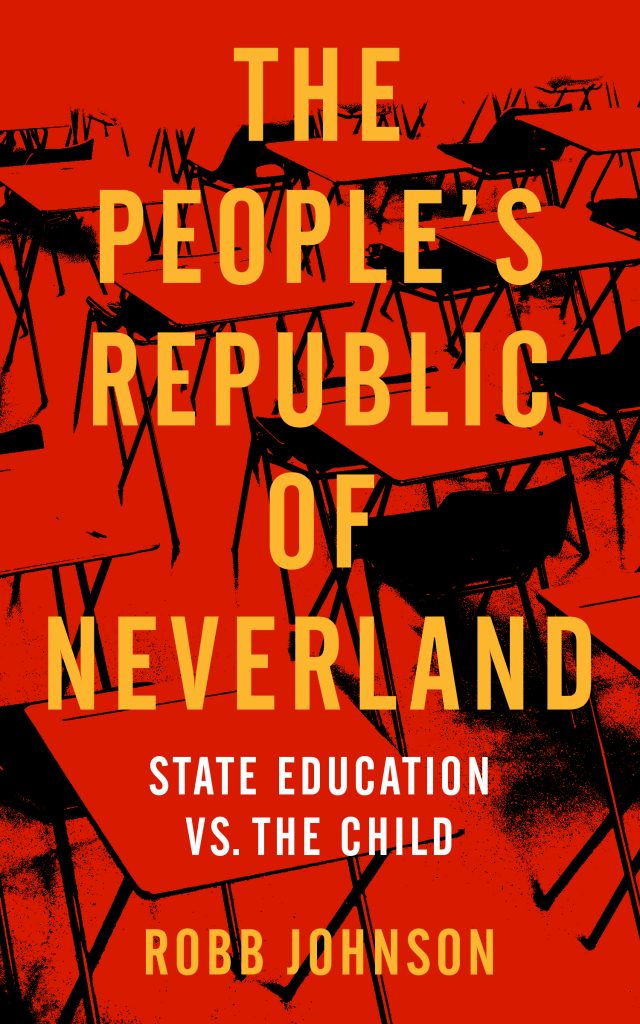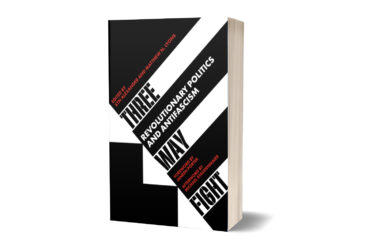New Frame
May 5th, 2021
Robb Johnson writes on behalf of children, finding in them curiosity and empathy mixed with wonderment – before the voracious capitalist society drills it out of them.

This is a lightly edited excerpt from The People’s Republic of Neverland: The Child Versus the State (PM Press, 2020) by Robb Johnson.
The Essential Anarchist
Each child born is born an anarchist.
– Robb Johnson, “At the Siege of Madrid”
The child, compared with the shifting slippery shape of the state, remains pretty much a constant. You get complaints about children not being children any more, you get totalitarian regimes claiming they are creating a “new type of man” and you get local conditions of culture and history and societal values seeping in from the word go, but, basically, the human animal doesn’t evolve or alter anywhere nearly as much as the society it finds itself in. The human animal does, however, have to express itself through the social languages it finds around it. As we have noted, the British state has attempted to control those languages through its assertion of control over schooling and, we might add, through its assertion of control over social relations and organisation (turning the working class into the unemployed class) and assertion of control over culture (through commodification and the mediation of the media) – all these strategies have attempted to exert almost medieval standards of complete control over the language of social discourse. This control shows particular intent and attention to the way that control of that language exercises ideological control over political debate. Between them, schools and media impose models of thinking and not thinking, of value and non-value, that are intended to be understood as more real than individual experience, action and reflection. So maybe children appear differently than they did in your experience of the past, partially because they have to work in a different language than the one you grew up with – toddlers, presented with a real old retro paper book, will be observed attempting to swipe pages rather than turn them, and five-year-olds will, as noted, talk about diagraphs as if that was somehow important learning for a five-year-old. But that’s just the language not the thing itself. The thing itself is still what it always was, an improbable and random flame of unique consciousness, wide-eyed, happy to be here, and curious to find out more.
People, eh?
You’ve got to love them, haven’t you? Here we are, billions of us, doing our best in metaphysically impossible conditions, happy pigs, unhappy Socrateses. We are, all of us, simultaneously nothing special and the centre of the universe. Most of us, the vast majority of us, are generally okay. Clearly, there are some individuals for whom something somewhere has gone wrong, so they become oppressors and exploiters, police and thieves, fascists, celebrities, bosses, mass murderers, politicians (sometimes, far too often, both at one and the same time). Beckett’s humorous final insult in Waiting for Godot is “critic”, mine might possibly be “Ofsted inspector”.
But children … they love the world. Che Guevara said, “True revolutionaries must perceive the revolution, because of its creative and liberating nature, as an act of love. … Let me say, with the risk of appearing ridiculous, that the true revolutionary is guided by strong feelings of love.” Children are very much guided by strong feelings of love. Each child carries the revolution wittingly or unwittingly under their breath and under their coat, like Brecht’s Galileo carries the truth under his breath and under his coat, loving the world as they do. Love has become a rather overworked and frequently devalued word, both as a noun and a verb, but it is nonetheless a pretty good description of a significant human characteristic and motivating factor. One of the positives about having worked as a teacher and having spent 23 years of my working life in the early years is that you get to see human beings as they are, at their best, usually – although increasingly not always – before things go wrong. Before capitalism sinks its teeth into them. Before the state makes sure their great expectations – which are really only that the world will respond in kind to their innate love of being alive – get well and truly disappointed. Children are humanity in its essence, and they – we – are hardwired to want to love the world.
Perhaps it is this active, conscious commitment and capacity that makes our brains that little bit different from – say – the brain of my great friend Ginger the cat, whose level, unperturbed gaze greets me from the screensaver every time I turn this iPad on. Paulo Freire, author of the aforementioned Pedagogy of the Oppressed, notes that “animals do not consider the world; they are immersed in it. In contrast human beings emerge from the world, objectify it, and in so doing understand it and transform it with their labour”. However, sometimes – all too often, in fact – children find that the world is organised to deny them their transformative energy. I would also add that humans are particularly characterised by their capacity for attachments that involve complex, sometimes irrational, counter-intuitive choices and behaviours. Attachment for humans is not just a biological necessity; attachment is also a psychological necessity, and what is often remarkable about our monsters is their history of failed significant attachments coupled with their persistent irrational substitute attachments – Hitler’s famous fondness for dogs, for example. One child I taught who had experienced a very loveless start to his life, contemplating a mill pond on school journey, was adamant he would rescue an animal in danger of drowning there but not a person. Indeed, the remarkable quality of indifference that is otherwise only found among humans, and generally in fictional forms like Alain Delon’s performance in Le Samourai (does that man ever take a shit, I find myself wondering?) may well be existentially satisfying but remains essentially fragile and fictional – and even Delon’s character turns out to have a fatal weakness for canaries… With humans there is this inescapable capacity for attachment to have an irrational and an aesthetic quality to it, and this is what transforms attachment into love.
Of course, Ginger feels no need to develop or own an iPad, with or without my frequently troubled gaze greeting him every time he switches it on. Attachment is a much more straightforward matter for Ginger, and, if I am honest, probably doesn’t ever entirely escape the rationality of transaction (although I do feel that our relationship has developed with at least a modicum of affection for me on Ginger’s part, but that could be just because I know where the cat treats are kept and can be persuaded more frequently than anyone else to dish them out). Whereas, surely, as humans, most of us have at some point been aware of and troubled by the irrationality of our attractions and the impossibility of certain of our transactions.
Love is both rational and irrational. Children are also both rational and irrational. Far too many adults underestimate a child’s ability to engage with reason, perhaps because they only notice the child’s delight and engagement in the irrational, the imagination and the playfulness that they have had squeezed out of them in their experience of “growing up”. Children have a great capacity to commit to delight for its own sake, with none of the ulterior motives of outcome that govern learned adult behaviour.
An anecdote: it is a school journey, and we are on the beach at Swanage at sunset. H (a very thoughtful and reflective 11-year-old) takes out her instamatic camera and points it at the beautiful horizon. P (a thoughtful but more practically inclined 11-year-old) sensibly counsels her friend, “It won’t come out.” “It doesn’t matter,” says H, as she clicks the camera.
Another characteristic of childhood is that it is a period when the individual’s growth and change is at its most manifest. The young human is notorious for being subject to phases of biological development. Yet each of these developments, which in many ways help construct the social identity of the individual, takes place individually, at differing rates and to differing degrees. There is the legendary “terrible twos”, there is the young child’s deep necessity for movement, which makes the traditional characteristics of formal schooling – sit down, be quiet, do your (written) work – categorically inappropriate for young children, particularly for boys; their bodies release luteinising hormone at around four years of age, affecting them the way testosterone levels affect adults. Gender is, of course, not a divide but a spectrum, but there are generally different rates at which different motor skills develop in boys and girls, and those of us at the boy end of the spectrum will have been likely to have found our brain development in the frontal cortex, caudate and temporal lobes (the thoughtful and analytical parts of the brain) lagging behind those of us on the girl end of the spectrum by as much as 20 months for much of our childhood. And then there’s adolescence… These are the species-specific biological realities of “growing up”, and to these must be added the challenges of a reflective consciousness that has to engage with “decentring”, balancing your own needs and aspirations with everybody else’s and coping with the awareness of self.
Decentring is a grandiloquent term for what is often more prosaically termed “caring and sharing”. Rather like love, these are two words that have somewhat lost their potency through overuse, although the meaning and social behaviour that they freight remain as socially potent as ever. Children have a pretty good instinctive capacity for empathy. They are also pretty good at cooperating rather than competing. My experience of working with children convinces me that children are infinitely happier and, therefore, in utilitarian terms, more effective as learners when they are functioning in a cooperative and empathetic caring and sharing environment. That is surely stating the obvious; when we are happy, we are better able to function and contribute. Nonetheless, since the Romantics started getting all introspective and maudlin as the Industrial Revolution kicked in, we find ourselves in the paradox of a cultural tradition where suffering and unhappiness have been seen as requisite elements to the creative process. In The Third Man, Graham Greene’s serpentine superman Harry Lime, who, like Milton’s Satan in Paradise Lost, gets all the best lines, is able to plausibly assert that three centuries of Swiss brotherly love produced the cuckoo clock, whereas 30 years of the Borgias produced the Renaissance. This belief that tyranny and suffering are the most efficacious conditions conducive to production has translated easily into the ethos underlying the treatment of children in many if not most classrooms up until the latter half of the last century.
As adults we are often faced with evidence that seems to support the idea that happiness is not conducive to “progress”. Paradoxically, unhappiness is seen as a great generator of creativity. The “world wars” of the 20th century saw the development of sciences that have since come to determine the subsequent development of much of the way human society is organised, from jet engines to computers, as well as expensive and costly initiatives like space programmes. Hey, thanks for the Velcro! Much easier for a four-year-old than laces. And thanks for nuclear energy and all the ingenious cruelty of modern weaponry. Discontent – certainly with the discovery of the teenager in the 1950s – has become synonymous with adolescence (rather than class?), and with the explosion of pop culture in the 1960s, adolescence became synonymous with creativity, making a direct link between behaviour and biology, as well as between culture and biology. The effect of biological change – menstruation and menopause – is seen as a significant factor for women. Men on the other hand are … what? Set in stone after their last shift of adolescent testosterone? Incapable of growth? Forever little boys lost in big boys’ clothes? I think I read somewhere all our body cells are replaced every seven years. How much of a constant am I anyway, even ignoring Sartre’s categorically conclusive proposition that existence precedes essence?






